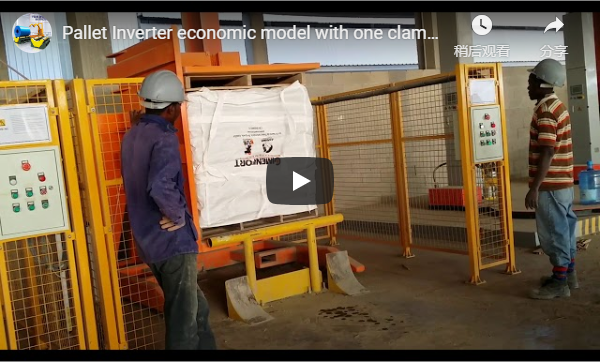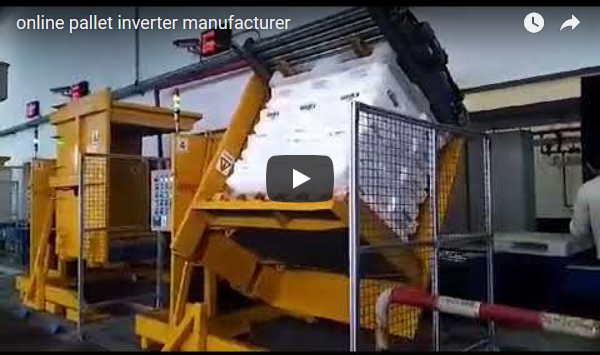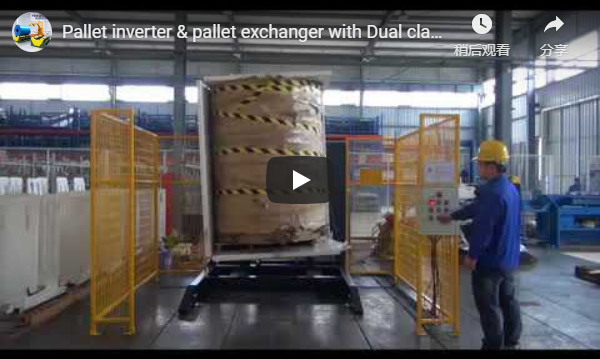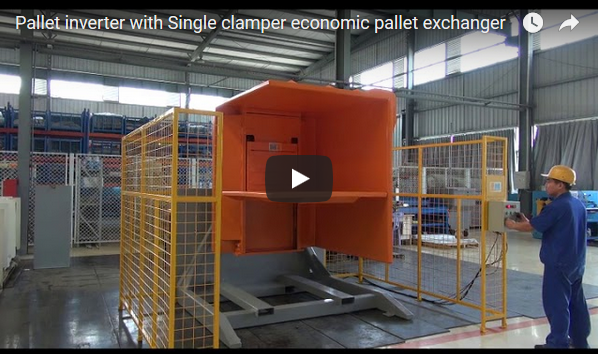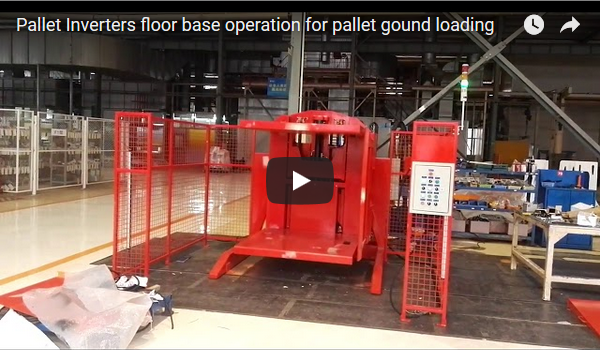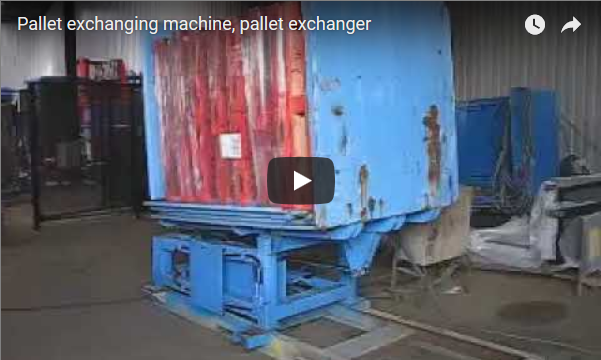Optimizing Load Transfer: The Engineering and Operation of 180-Degree Pallet Changers
Introduction: The Evolution of Pallet Handling
In modern logistics, warehousing, and manufacturing environments, the efficient and safe handling of palletized goods is paramount. Traditional manual methods are increasingly inadequate, facing challenges related to labor costs, ergonomic risks, and product integrity. [Automated pallet transfer systems], particularly 180-degree pallet changers (also known as pallet inverters), represent a significant engineering advancement designed to address these challenges. This article delves into the operational principles, design considerations, technical specifications, and benefits of utilizing 180-degree pallet changers, aligning with the technical focus expected by readers familiar with advanced machine design principles.
The Operational Imperative: Addressing Modern Handling Challenges
Manual pallet handling, especially tasks involving inverting or transferring heavy loads between different pallet types (e.g., wood to plastic, house pallet to shipping pallet), presents significant operational hurdles:
- Ergonomic Risks: Manual lifting and flipping of heavy or unstable loads pose substantial risks of musculoskeletal disorders (MSDs) for personnel, contributing to lost workdays and increased insurance premiums. Regulatory bodies like OSHA emphasize the need for engineering controls to mitigate such hazards.
- Product Damage: Awkward manual manipulation or the use of inadequate equipment can lead to dropped loads, crushing, or contamination, resulting in costly product loss and waste. This is particularly critical in industries like pharmaceuticals and food & beverage.
- Operational Inefficiency: Manual processes are inherently slower, require more labor, and can become bottlenecks in high-throughput environments. The lack of consistency can also impact downstream processes.
- Hygiene and Contamination Control: Transferring goods from external or less hygienic pallets (like wood) to internal, sanitized pallets (like plastic or aluminum) is crucial in food, pharmaceutical, and cleanroom environments. Manual transfers increase contamination risks.
- Maintenance & Tooling Costs: Reliance on specialized, often cumbersome manual tools for load inversion can lead to high maintenance expenses and limited flexibility.
Engineering Design & Operational Principles of 180-Degree Pallet Changers

The core function of a 180-degree pallet changer is to securely clamp a palletized load, rotate it through 180 degrees, allowing the original pallet to be removed from the top and replaced with a new one, before rotating the load back (or allowing removal in the inverted state). Key engineering aspects include:
Clamping Mechanism:
Utilizing robust side-clamping walls, often hydraulically or electro-mechanically actuated, the system applies controlled pressure to secure the load during rotation. Advanced systems feature adjustable pressure settings, managed via PLC (Programmable Logic Controller), to accommodate varying load types and prevent product damage. Pressure sensors provide feedback for precise control, a concept refined in numerous material handling patents focusing on load stability (e.g., conceptual parallels in US Patent classes for load handling).
Rotational Drive System:
The 180-degree rotation is typically powered by a heavy-duty hydraulic motor and gear system or a powerful electro-mechanical drive. The design must ensure smooth, controlled acceleration and deceleration to maintain load integrity. Finite Element Analysis (FEA) is often employed during the design phase to optimize structural components and ensure durability under repeated high-torque cycles.
Control System & Interface:
Modern pallet changers feature sophisticated control systems, usually PLC-based, with intuitive Human-Machine Interfaces (HMIs). These allow operators to:
- Select pre-programmed cycles for different load types.
- Adjust clamping pressure and rotation speed.
- Monitor system status and diagnostics.
- Integrate with warehouse management systems (WMS) or automated guided vehicles (AGVs).
Control precision ensures repeatable performance and safety interlock management.
Safety Features:
Compliance with safety standards (e.g., CE marking in Europe, OSHA guidelines in the US) is critical. Standard safety features include:
- Perimeter guarding or light curtains to prevent operator access during operation.
- Emergency stop buttons strategically located.
- Hydraulic pressure relief valves.
- Interlocks preventing rotation if the load is not properly secured or guards are open.
- Controlled stop mechanisms in case of power failure.
Key Performance Specifications
Understanding the technical parameters is crucial for selecting and integrating the right pallet changer:
- Load Capacity: Typically ranges from 1000 kg to 2000 kg (approx. 2200 lbs to 4400 lbs), with heavy-duty models available.
- Pallet Size Compatibility: Designed for standard pallet dimensions (e.g., 1200x1000mm, 1200x800mm, 48"x40"). Customizable platforms accommodate various sizes, including specific configurations like 1000x1000mm, 1200x1200mm, and 1200x1300mm as mentioned for specific applications.
- Rotation Angle: Fixed at 180 degrees for inversion.
- Clamping Range: Adjustable opening to accommodate varying load heights.
- Cycle Time: Varies depending on the model and load, but typically optimized for efficiency (e.g., 30-60 seconds per cycle).
- Control Interface: PLC with HMI touchscreen panel.
- Power Requirements: Typically 380V/400V/450V, 3-phase, 50/60Hz. Specific current draw depends on the motor size.
- Construction Materials: Heavy-gauge structural steel frame, often powder-coated for durability. Stainless steel options are available for hygienic applications.
- Safety Compliance: Designed to meet relevant ISO, ANSI, and CE standards.
Applications Across Industries
The versatility of 180-degree pallet changers makes them suitable for a wide range of sectors:
- Pharmaceutical & Chemical: Ensuring product integrity, preventing cross-contamination by switching to in-house pallets, handling drums and IBCs safely.
- Food & Beverage: Maintaining hygiene standards, transferring goods from wooden to plastic pallets, handling bagged goods, boxes, and crates.
- Logistics & Distribution: Improving warehouse efficiency, enabling quick transfer between different pallet types (rental, shipping, internal), reducing manual handling risks.
- Manufacturing: Transferring finished goods onto shipping pallets, handling delicate components, integrating into automated production lines.
Benefits Beyond Basic Handling: A Technical Perspective
Implementing a 180-degree pallet changer offers tangible engineering and operational advantages:
- Enhanced Ergonomics & Safety: Directly addresses manual handling risks, aligning with occupational health recommendations (e.g., NIOSH lifting guidelines) by automating strenuous tasks.
- Product Integrity & Damage Reduction: Controlled clamping pressure and smooth rotation minimize the G-forces experienced by the load, reducing damage potential compared to manual methods or less sophisticated equipment.
- Operational Efficiency & Throughput: Consistent, automated cycle times increase predictability and overall throughput compared to variable manual processes. Research published in logistics journals often highlights the significant ROI from such automation.
- Hygiene & Contamination Control: Provides a reliable method for isolating external contaminants by facilitating pallet exchange in controlled environments.
- Flexibility & Customization: Adaptable designs accommodate various load types (rolls, trays, panels, boxes, bags) and sizes. Customizations can include specific finishes, integration protocols (e.g., Profibus, Ethernet/IP), and specialized guarding.
- Reduced Operating Costs: Lower costs associated with labor, product damage, waste disposal, and potential injury claims contribute to a favorable total cost of ownership (TCO).
Integration and Customization Potential
These machines are rarely standalone units in modern facilities. They are designed for integration:
- Conveyor Systems: Input and output roller or chain conveyors facilitate seamless flow into and out of the pallet changer.
- AGV/AMR Compatibility: Floor-level loading models can be designed for access by automated guided vehicles or autonomous mobile robots.
- Custom Tooling: Specialized clamping attachments can be engineered for non-standard loads.
- Environmental Adaptations: Options for cold storage (-30°C), cleanroom (stainless steel), or explosive atmospheres (ATEX) are often available.
Conclusion: Enhancing Operations Through Engineered Solutions
The 180-degree pallet changer is more than just a piece of material handling equipment; it is an engineered solution designed to address critical operational challenges in safety, efficiency, and product care. By leveraging controlled clamping and rotation mechanisms, robust construction, and advanced safety features, these systems provide a reliable and efficient method for pallet exchange and load inversion across diverse industries. Investing in such technology aligns with lean manufacturing principles, enhances workplace safety, and contributes significantly to optimizing supply chain operations.
Contact Us Now
Elevate your material handling process with a technically advanced pallet changing solution. Contact our engineering team today to discuss your specific application requirements, receive a custom quote, or schedule a virtual or in-person demonstration. Let us help you engineer greater efficiency and safety into your operations.
Frequently Asked Questions (FAQs)
1. What types of loads can the 180-degree pallet changer handle besides standard pallets?
These machines are versatile and can be adapted to handle various loads, including boxed goods, bagged products (like grains or chemicals), drums, rolls (paper, foil), trays, and panel products, often with minor adjustments or specific clamping configurations.
2. How does the clamping system avoid damaging sensitive products?
Advanced pallet changers utilize adjustable hydraulic or electro-mechanical pressure control systems, often managed via PLC. This allows operators to set the precise clamping force required for load stability without exerting excessive pressure that could damage sensitive or fragile goods. Pressure feedback sensors ensure consistency.
3. What are the primary safety standards these machines are designed to meet?
Reputable manufacturers design pallet changers to comply with international and regional safety standards, such as ISO 12100 (Safety of machinery), IEC 60204 (Electrical safety), and applicable sections of ANSI/ITSDF B56 standards (for industrial trucks, if applicable interface exists). CE marking is standard for machines sold in Europe. Specific safety features include interlocked guarding, E-stops, and controlled motion.
4. What are the typical power and utility requirements?
Most industrial models require a three-phase electrical supply (e.g., 380V, 400V, 450V, or 480V at 50/60Hz). The required amperage depends on the motor size. Some models may also require a compressed air supply for certain pneumatic functions, although hydraulic power packs are common for the main clamping and rotation.
5. Can the system handle different pallet sizes and types interchangeably?
Standard models are typically designed for common pallet footprints. However, many systems offer adjustable platforms or are customizable during manufacturing to accommodate a range of sizes, including 1000x1000mm, 1200x1200mm, 1200x1300mm, GMA pallets, CHEP pallets, and Euro pallets. Specify your required range during consultation.
6. What level of maintenance is typically required?
Routine maintenance usually involves periodic inspection of hydraulic systems (fluid levels, hoses, connections), lubrication of moving parts (bearings, gears), checking electrical connections, and verifying safety feature functionality (E-stops, light curtains). Manufacturers provide detailed maintenance schedules. Well-maintained systems offer high reliability.
7. How does the 180-degree rotation ensure complete and safe inversion?
The system uses a robust rotational mechanism, often a gear drive coupled with a hydraulic or electric motor, designed to handle the specified load capacity with a significant safety factor. The load is securely clamped before rotation begins, and the 180-degree turn is precisely controlled by the PLC to ensure a smooth, complete inversion without shifting or instability.
For more detailed technical specifications, customization options, or to discuss how a 180-degree pallet changer can be integrated into your specific workflow, please contact our technical sales team. We are committed to providing engineered solutions that enhance your operational efficiency and safety.

